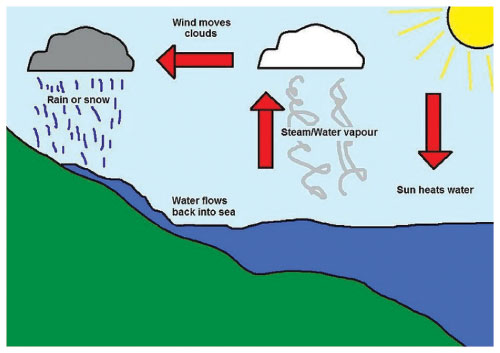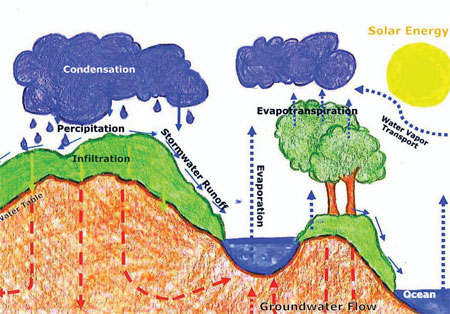How does rain form?
Water droplets form from warm air. As the warm air rises in the sky
it cools. Water vapour (invisible water in the air) always exists in our
air. Warm air holds quite a bit of water. For example, in the summer it
is usually very humid. When enough of these droplets collect together,
we see them as clouds.

If the clouds are big enough and have enough water droplets, the
droplets bang together and form even bigger drops. When the drops get
heavy, they fall because of gravity, and you see and feel rain.
What causes rain?
When clouds develop or rain occurs, something is making the air rise.
Several things can make this happen. Mountains, low-pressure areas, cold
fronts, and even the jet stream.
How big are raindrops?
Raindrops are much smaller than we think! They are actually smaller
than a centimetre. Raindrops range from 1/100 inch (.0254 centimetre) to
1/4 inch (.635 centimetre) in diameter.
How fast do raindrops fall?
Not including wind-driven rain, raindrops fall between 7 and 18 miles
per hour (3 and 8 metres per second) in still air.
The range in speed depends on the the size of the raindrop. Air
friction breaks up raindrops when they exceed 18 miles per hour.
What is flood?
A flood results from days of heavy rain and/or melting snows, when
rivers rise and go over their banks.
What is a flash flood?
A flash flood is sudden flooding that occurs when floodwaters rise
rapidly with no warning within several hours of an intense rain.
They often occur after intense rainfall from slow moving
thunderstorms. In narrow canyons and valleys, floodwaters flow faster
than on flatter ground and can be quite destructive.
Do flash floods hurt people?
Flash floods are the number one weather-related killer in the U.S.
Nearly 80 percent of flash flood deaths are auto related. Know
beforehand if your area is a flood risk.
How much water is needed for your car to float away?
A mere two feet of water can float a large vehicle or even a bus.
This is why you should never drive through flooded roads. Just six
inches of rapidly moving flood water can knock a person down.
What is a monsoon?

A monsoon is a seasonal wind, found especially in Asia that reverses
direction between summer and winter and often brings heavy rains. In the
summer, a high pressure area lies over the Indian Ocean while a low
exists over the Asian continent. The air masses move from the high
pressure over the ocean to the low over the continent, bringing
moisture-laden air to south Asia.
During winter, the process is reversed and a low sits over the Indian
Ocean while a high lies over the Tibetan plateau so air flows down the
Himalaya and south to the ocean. The migration of trade winds and
westerlies also contributes to the monsoons. Smaller monsoons take place
in equatorial Africa, northern Australia and to a lesser extent, in the
southwestern United States.
-Internet
Rain Facts
Did you know that rain occurs on other planets? Or that Antarctica is
the driest continent on Earth? Understand how rain works and why it is
so important to life here on Earth with our fun rain fact for children.
*Rain falls from clouds in the sky in the form of water droplets,
this is called precipitation.
*Water can also fall from the sky in the form of hail, sleet or snow.
*Rain is an important part of the water cycle. Learn how it works
with our page explaining the water cycle for children.
* Rain occurs on other planets in our Solar System but it is
different to the rain we experience here on Earth. For example, rain on
Venus is made of sulfuric acid and due to the intense heat it evaporates
before it even reaches the surface!
* Weather radar is used to detect and monitor rain.
* Rain gauges are used to measure the amount of rain over a certain
period of time. Try making your own rain gauge.
* The highest amount of rainfall ever recorded in 24 hours is 182.5
centimetres (71.9 inches) in Foc-Foc, La Réunion. This occurred during
tropical cyclone Denise on January 8, 1966.
* The highest amount of rainfall ever recorded in one year is 25.4
metres (1000 inches) in Cherrapunji, India.
* Antarctica is the driest continent on Earth.
* Heavy rain can cause flooding and landslides.
* Rain allows us to create electricity through hydropower.
* Plants need water to survive, they receive much of this water from
rain.
* Forests that experience high levels of rainfall are called
rainforests.
* Rain with high levels of acid (a low pH) is called acid rain.
Caused by the release of sulphur dioxide and nitrogen oxides into the
air (often from factories and power stations), it can be harmful to
plants and animals. |

